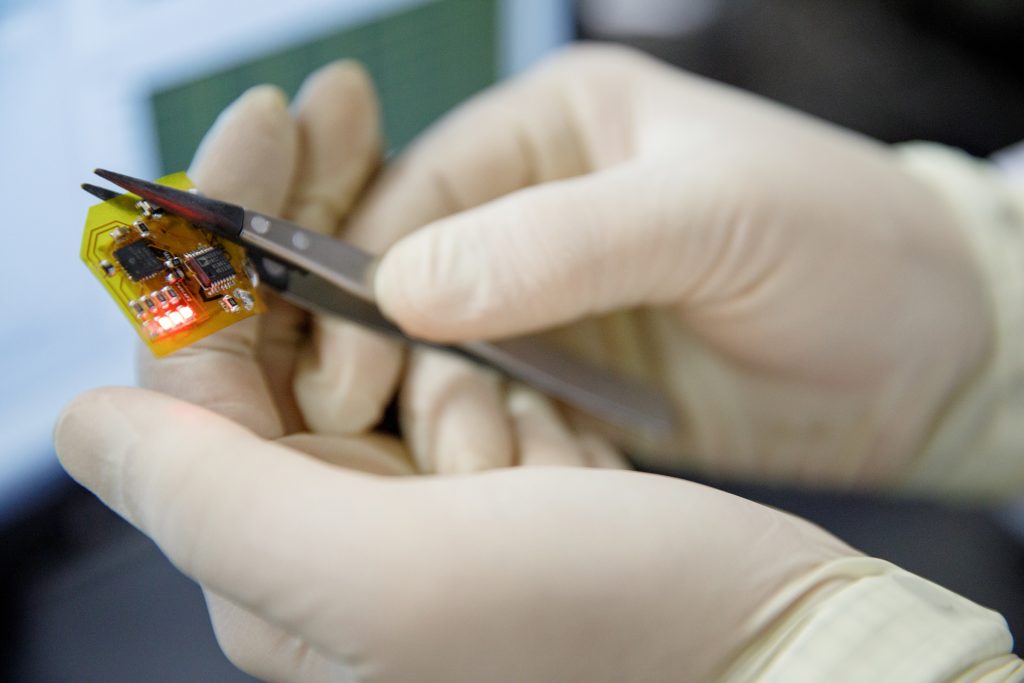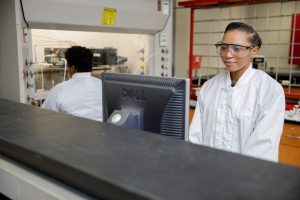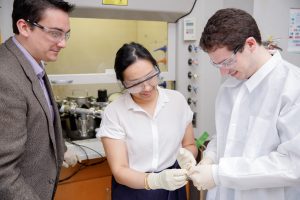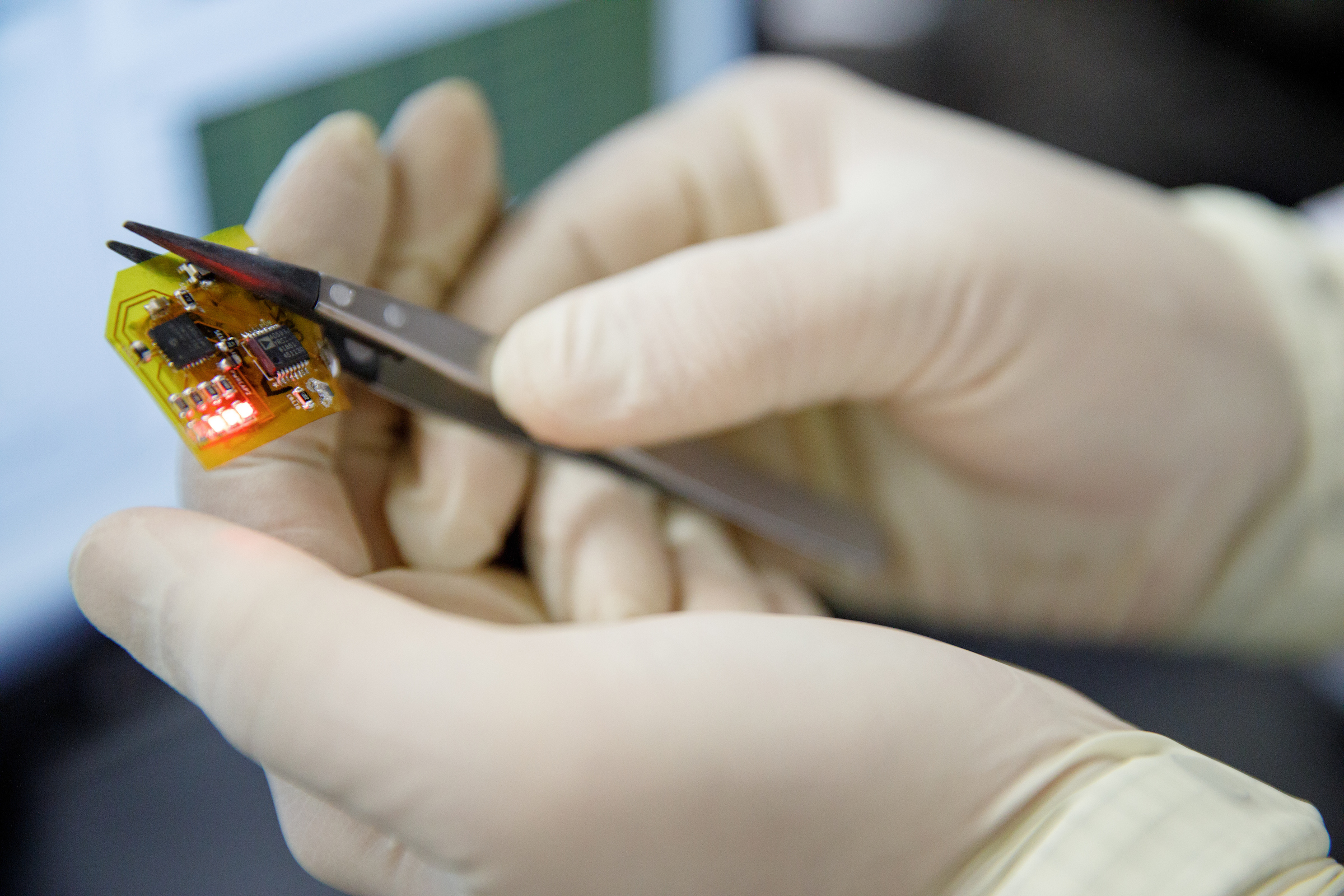
UA Researchers Working with Army to Develop Inexpensive, Lightweight Devices to Detect Toxic Chemicals
Consider string instruments. Whether strung on a violin, harp or a guitar, the vibration of a string on an instrument creates specific sounds. Change the way the string vibrates, or oscillates, and a different musical note is heard.
Like oscillations of a string, electrons in a solid oscillate at specific frequencies. These frequencies change by contact with chemicals, much like fingers on a musical instrument.
Researchers at The University of Alabama are working with Army scientists to develop and use this chemical symphony to quickly detect dangerous airborne chemicals. The technology uses electrical signals to tune in to specific frequencies corresponding to chemical weapons, toxic industrial chemicals or explosives. These chemicals can be impossible for humans to detect on their own, and rapid detection is challenging.

Dr. Adam Hauser, an assistant professor in the department of physics and astronomy at UA, collaborates with the U.S. Army Combat Capabilities Development Command Chemical Biological Center, or CCDC CBC, in Maryland on developing the technology. Dr. Jennifer Soliz, a CCDC CBC research chemist, developed sensing materials that permanently change color when interacting with chemical weapons. The technology could increase situational awareness for the soldiers and first responders of what dangers lie ahead.
“We are tuning into a specific frequency of electrons in the sensing material, much as one would listen for a specific instrument within a symphony,” said Dr. Adam Hauser, UA physicist. “Frequency selection allows the sensor born from Dr. Soliz’s incredible materials to be more selective for a specific chemical threat than currently available methods.”
The sensors are a significant breakthrough for their sensing capabilities alone but are also incredibly small and affordable compared to current technology. Depending on the mission, soldiers can carry about 75 pounds of equipment. The sensor developed by this collaboration weighs less than 2 grams and are much less expensive than current chemical sensors.
Roughly the size of a quarter, they could be placed on drones or woven into equipment. They could alert soldiers of toxic chemicals before they entered an area, or first responders could detect the spread of dangerous chemicals at the site of an industrial accident.
“They are designed to be small, inexpensive and disposable because sensing a dangerous chemical means contaminating the sensor itself,” Hauser said. “If the device can be discarded, it is safer for our warfighter and avoids high equipment decontamination costs for the taxpayer.”
When the selective materials from CCDC CBC combine with the co-developed chemical sensors, the resulting technology can sweep for the signature of a specific chemical threat and sense the change.

“This method allows greater selectivity with fewer probe elements, allowing devices that are smaller and less expensive than devices of similar performance,” Hauser said. “There is no perfect chemistry that selects for one airborne chemical while reacting to nothing else, but the sensing materials synthesized by Dr. Soliz has shown promising results. Our frequency method synergistically enhances the chemical selectivity to new heights.”
The technology could save lives placed on drones or part of equipment and vehicles. A swarm of small drones could detect the size and shape of a toxic gas at an industrial accident, for instance, giving first responders an idea of contaminated areas or a map of a battlefield with suspected chemical weapons. The technology could work in cities as a passive grid that monitors and alerts for gases.
Dr. Hauser said the next steps involve integrating artificial intelligence and machine learning to provide more data to soldiers or responders. A spin-off company, Foresense Solutions LLC, has licensed the technology from UA, and it is completing a federal program for start-up businesses.
“The goal of the spin-off company is to accelerate research and development at the applied level,” Hauser said. “We are doing whatever needs to be done to get help to the warfighter the fastest. It would be great to have a successful company, but the focus is on getting it to the field to save lives.”
Dr. Hauser is an assistant professor of physics and astronomy. The U.S. Army supports the scientific research, and marketing research is supported by the National Science Foundation Innovation Corps.
Approved for public release by the U.S. Army; distribution unlimited.
